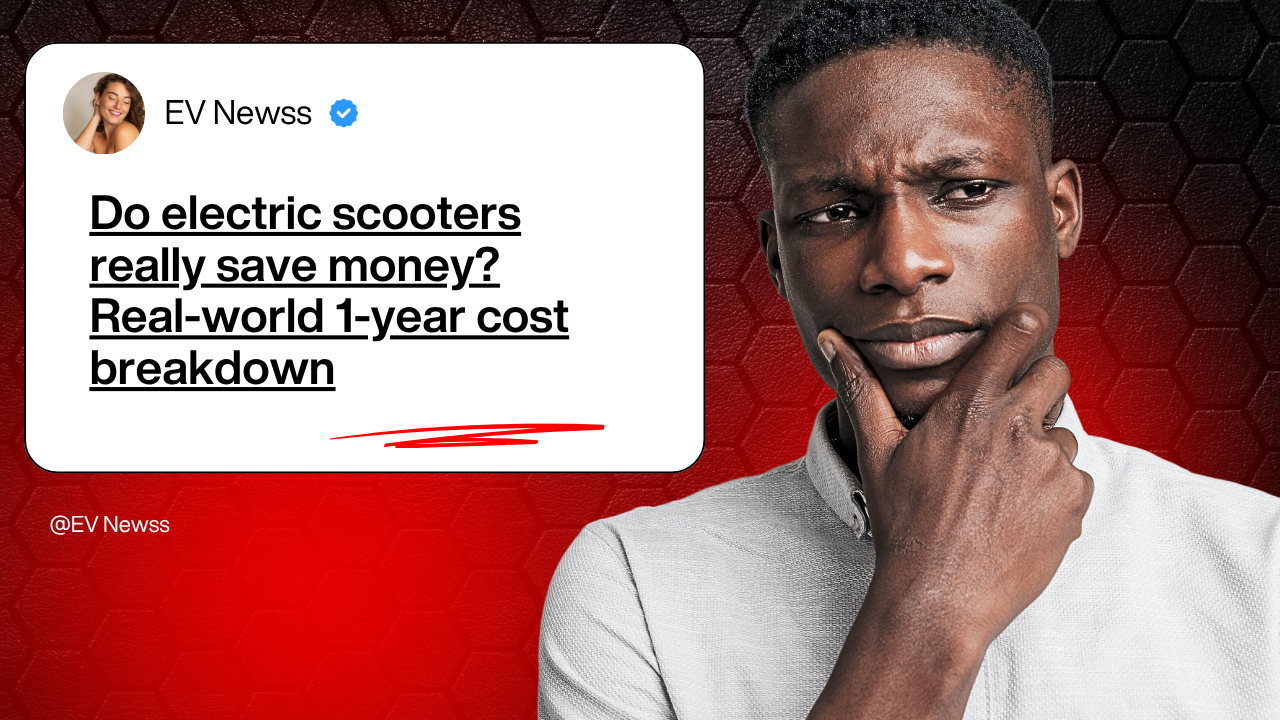In 2025, electric scooters are everywhere—from city commuters in Mumbai and Bengaluru to students in smaller towns. But a question persists in the minds of Indian buyers: Do electric scooters really save money compared to petrol scooters? Or is the hype just marketing?
To answer that, we’ve done a real-world 1-year cost breakdown, comparing electric and petrol two-wheelers across purchase, charging/fuel, maintenance, insurance, and more. The results may surprise you.
Let’s dive into the data, compare Ola, Ather, TVS iQube, and their petrol counterparts, and understand whether an electric scooter truly saves money over time.
Initial Purchase Price: Higher, But Closing Gap
| Vehicle | Price (Ex-showroom) | On-Road Price (Incl. Subsidy) |
|---|---|---|
| Ola S1 Air | ₹1,10,000 | ₹95,000 |
| TVS iQube | ₹1,35,000 | ₹1,10,000 |
| Ather 450X | ₹1,65,000 | ₹1,35,000 |
| Honda Activa 125 | ₹90,000 | ₹1,00,000 |
| Suzuki Access 125 | ₹88,000 | ₹98,000 |
While petrol scooters have a lower initial cost, state and central EV subsidies are narrowing the gap, especially for Ola and TVS.
Fuel vs Charging Cost: The Real Savings
Let’s assume:
- Daily commute: 30 km
- Monthly distance: 900 km
- Petrol cost (avg.): ₹105/litre
- Scooter mileage: ~45 km/litre
- Electricity rate: ₹8/kWh
- EV efficiency: 35 km per unit
Annual Fuel Cost (Petrol Scooter): – 900 km/month ÷ 45 km/l = 20L × ₹105 = ₹2,100/month × 12 = ₹25,200/year
Annual Charging Cost (Electric Scooter): – 900 km/month ÷ 35 km/unit = 26 units × ₹8 = ₹208/month × 12 = ₹2,496/year
✅ You save over ₹22,000 a year on fuel alone with an electric scooter.
Maintenance Cost Comparison
| Component | Petrol Scooter | Electric Scooter |
| Engine Oil | ₹600 every 3 months | None |
| Air Filter | ₹300 annually | None |
| Belt/Clutch | ₹1,500 annually | None |
| Brake Pads | ₹500 annually | ₹400 annually |
| General Service | ₹1,200 twice a year | ₹500 annually |
Total Annual Maintenance Cost:
- Petrol: ~₹5,000
- Electric: ~₹900
✅ Annual savings: ₹4,100
Insurance, Registration & Road Tax
EVs in many states get road tax exemption and reduced registration charges. Also, insurance premiums are usually cheaper.
| Cost Head | Petrol Scooter | Electric Scooter |
| Road Tax | ₹3,000 | ₹0 (many states) |
| Registration | ₹2,000 | ₹1,000 |
| Insurance (1 yr) | ₹2,500 | ₹1,800 |
✅ Extra savings: ₹4,700 in year one
Battery Replacement Worries? Not So Fast
A major concern is battery life. Most electric scooters come with 3–5 year warranties and real-world usage shows:
- Ather batteries last over 5 years with 70–80% efficiency.
- Ola and TVS offer 8-year battery warranty options.
So, within your first year, battery replacement is NOT a concern.
1-Year Real-World Ownership Cost Comparison
| Cost Component | Petrol Scooter | Electric Scooter |
| Initial Cost (On-Road) | ₹1,00,000 | ₹1,10,000 |
| Fuel/Charging | ₹25,200 | ₹2,496 |
| Maintenance | ₹5,000 | ₹900 |
| Insurance, Tax etc. | ₹7,500 | ₹2,800 |
| Total (1 Year) | ₹1,37,700 | ₹1,16,196 |
✅ Net savings in Year 1: ₹21,504
If you keep the EV scooter for 3 years, you can save over ₹60,000 easily.
Additional Benefits of EV Scooters
- ✅ Low Noise & Zero Emissions
- ✅ Less vibration = smoother ride
- ✅ OTA updates with smart features
- ✅ Regenerative braking = longer brake life
- ✅ Ideal for urban stop-go traffic
When Do EV Scooters Not Make Sense?
While EVs are cost-effective, they may not be the best option if:
- You live in a rural area with no charging access
- You regularly travel 100+ km per day
- You need very high speed/performance (rare in budget EVs)
In such cases, hybrid or ICE options might be more practical.
FAQs – Electric Scooter Cost Savings in India
Q1. Are electric scooters really cheaper in the long run?
Yes. Lower running and maintenance costs make them more affordable over 2–3 years.
Q2. How long do electric scooter batteries last?
On average, 5–7 years depending on use and charging habits. Most brands offer warranties.
Q3. Is charging an EV scooter expensive?
Not at all. You can charge an average scooter for under ₹250/month.
Q4. Are subsidies still available in 2025?
Yes, though revised. Many states still offer incentives on top of national FAME policies.
Q5. Can I charge an electric scooter at home?
Yes, using a standard 5A socket. Most users charge overnight.
Conclusion: Yes, They Absolutely Save Money
After a year of ownership, electric scooters clearly offer substantial savings over petrol alternatives—₹20,000 or more in the first year alone. With rising fuel prices and lower EV maintenance, the economics favor electric two-wheelers.
So if your commute is under 40 km/day, you have home charging access, and are looking to save money over the next few years—buying an electric scooter in 2025 is a smart move.
Stay tuned to EV Newss for more cost breakdowns, real-world ownership stories, and expert EV advice.
READ OUR OTHER RECENT POSTS

1 thought on “Do electric scooters really save money? Real-world 1-year cost breakdown”